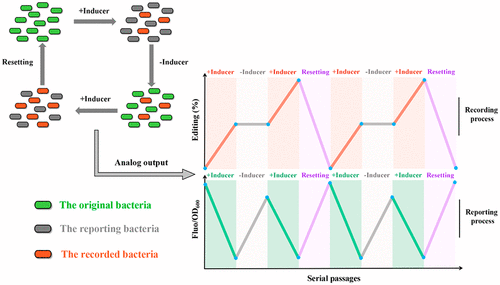当前位置:
X-MOL 学术
›
ACS Synth. Biol.
›
论文详情
Our official English website, www.x-mol.net, welcomes your feedback! (Note: you will need to create a separate account there.)
Long-Term Rewritable Report and Recording of Environmental Stimuli in Engineered Bacterial Populations.
ACS Synthetic Biology ( IF 4.7 ) Pub Date : 2020-08-14 , DOI: 10.1021/acssynbio.0c00193 Zhen-Ping Zou 1 , Bang-Ce Ye 1, 2
ACS Synthetic Biology ( IF 4.7 ) Pub Date : 2020-08-14 , DOI: 10.1021/acssynbio.0c00193 Zhen-Ping Zou 1 , Bang-Ce Ye 1, 2
Affiliation

|
DNA writing (living sensing recorders) based whole-cell biosensors can capture transient signals and then convert them into readable genomic DNA changes. The primitive signals can be easily obtained by sequencing technology or analysis of protein activity (such as fluorescent protein). However, the functions of the current living sensing recorders still need to be expanded, and the difficulty of rewriting in complex biological environments has further limited their applications. In this study, we designed a long-term rewritable recording system using a CRISPR base editor-based synthetic genetic circuit, named CRISPR-istop. This system can convert stimuli into changes in the fluorescence intensity (reporter) and single-base mutations in genomic DNA (recording). Furthermore, we updated the biological circuit through the strategy of coupling the single-base mutation (record site) and the loss-of-function of the targeted protein (translation stopped by stop codon introduction), and we can remove edited bacteria from a population through selective sweeps upon applying a selective pressure. It successfully conducted the rewritable reporter and recording of the nutrient arabinose and pollutant arsenite with two rounds of continuous operation (10 passages/round, 12 h/passage). These observations indicated that the CRISPR-istop system can report and record stimuli over time; moreover, the recording can be manually erased and rewritten as needed. This method has great potential to be extended to more complicated recording systems to execute sophisticated tasks in inaccessible environments for synthetic biology and biomedical applications, such as monitoring disease-relevant physiological markers or other molecules.
中文翻译:

工程细菌种群中环境刺激的长期可重写报告和记录。
基于 DNA 写入(活体传感记录器)的全细胞生物传感器可以捕获瞬态信号,然后将它们转换为可读的基因组 DNA 变化。通过测序技术或蛋白质活性分析(如荧光蛋白)可以很容易地获得原始信号。然而,目前的活体传感记录器的功能仍有待扩展,复杂生物环境下的改写难度进一步限制了其应用。在这项研究中,我们使用基于 CRISPR 碱基编辑器的合成遗传电路设计了一个长期可重写记录系统,名为 CRISPR-istop。该系统可以将刺激转化为荧光强度的变化(报告基因)和基因组 DNA 的单碱基突变(记录)。此外,我们通过将单碱基突变(记录位点)和目标蛋白功能丧失(因引入终止密码子而停止翻译)耦合的策略更新了生物回路,我们可以通过选择性从种群中去除编辑过的细菌在施加选择压力时进行扫掠。连续两轮操作(10代/轮,12小时/代),成功实现了营养阿拉伯糖和污染物亚砷酸盐的可重写报告和记录。这些观察结果表明,CRISPR-istop 系统可以随着时间的推移报告和记录刺激;此外,录音可以根据需要手动擦除和重写。
更新日期:2020-09-20
中文翻译:

工程细菌种群中环境刺激的长期可重写报告和记录。
基于 DNA 写入(活体传感记录器)的全细胞生物传感器可以捕获瞬态信号,然后将它们转换为可读的基因组 DNA 变化。通过测序技术或蛋白质活性分析(如荧光蛋白)可以很容易地获得原始信号。然而,目前的活体传感记录器的功能仍有待扩展,复杂生物环境下的改写难度进一步限制了其应用。在这项研究中,我们使用基于 CRISPR 碱基编辑器的合成遗传电路设计了一个长期可重写记录系统,名为 CRISPR-istop。该系统可以将刺激转化为荧光强度的变化(报告基因)和基因组 DNA 的单碱基突变(记录)。此外,我们通过将单碱基突变(记录位点)和目标蛋白功能丧失(因引入终止密码子而停止翻译)耦合的策略更新了生物回路,我们可以通过选择性从种群中去除编辑过的细菌在施加选择压力时进行扫掠。连续两轮操作(10代/轮,12小时/代),成功实现了营养阿拉伯糖和污染物亚砷酸盐的可重写报告和记录。这些观察结果表明,CRISPR-istop 系统可以随着时间的推移报告和记录刺激;此外,录音可以根据需要手动擦除和重写。


























 京公网安备 11010802027423号
京公网安备 11010802027423号